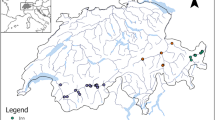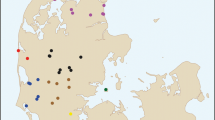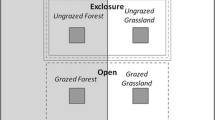Abstract
The statistical modelling of joint species abundance is currently receiving increasing attention in the ecological literature because it complements earlier descriptive accounts of the effect of disturbance on community change with quantitative measures of spatial covariation among species at different spatial scales. Using a hierarchical Bayesian approach, we fitted both temporal and spatial plant cover data to a joint distribution model of plant abundance of the dominant plants in wet heathlands (Erica tetralix, Calluna vulgaris and Molinia caerulea) undergoing nitrogen deposition over several decades. The spatial analysis was based on pin-point cover data from 114 Danish sites with a total of 1509 randomly placed plots along a nitrogen deposition gradient. The temporal analysis was based on pin-point cover data from 22 sites with a total of 986 observations from plots that had been resampled at least three times since 2007. The spatial variation was partially explained by nitrogen deposition, as the cover of Erica decreased significantly with nitrogen deposition, whereas the cover of both Calluna and Molinia increased (albeit non-significantly) with nitrogen deposition. There was a strong and significant positive spatial covariation between Erica and Calluna. Oppositely, there was a strong and significant negative spatial covariation between Calluna and Molinia. The spatial covariation between Erica and Molinia was not significantly different from zero. There were no significant changes in the cover of any of the three species since 2007. However, by including data from 2004, the previously reported result of a significant decreasing cover of Erica was confirmed, and the cover of Calluna increased significantly. We conclude that the statistical modelling of joint species abundance is a potentially powerful tool to understand the effect of the alteration of nitrogen dynamics on community composition. This is essential to design management practices aligned with the predicted effects of varying levels of nitrogen deposition on community structure. The study also demonstrated the insight gained on the community dynamics by the use of hierarchical Bayesian models.


Similar content being viewed by others
References
Aber JD, Goodale CL, Ollinger SV, Smith M-L, Magill AH, Martin ME, Hallett RA, Stoddard JL (2003) Is nitrogen deposition altering the nitrogen status of northeastern forests? Bioscience 53:375–389
Aerts R (1993a) Biomass and nutrient dynamics of dominant plant species from heathland. In: Heathlands. Patterns and processes in a changing environment (eds. R. Aerts & G. W. Heil). Geobotany 20:51–84
Aerts R (1993b) Competition between dominant plant species in heathlands. In: Aerts R, Heil GW (eds) Heathlands: patterns and processes in a changing environment. Kluwer Academic Publishers, Dordrecht
Aerts R, Berendse F (1988) The effect of increased nutrient availability on vegetation dynamics in wet heathlands. Vegetatio 76:63–69
Aerts R, Ludwig F (1997) Water-table changes and nutritional status affect trace gas emissions from laboratory columns of peatland soils. Soil Biol Biochem 29:1691–1698
Bak JL (2014) Critical loads for nitrogen based on criteria for biodiversity conservation. Water Air Soil Pollut 225:1–13
Bannister P (1966) Erica tetralix L. J Ecol 54:795–813
Berendse F (1994) Competition between plant populations at low and high nutrient supplies. Oikos 71:253–260
Berendse F (1998) Effects of dominant plant species on soils during succession in nutrient-poor ecosystems. Biogeochemistry 42:73–88
Bobbink R, Hicks K, Galloway J, Spranger T, Alkemade R, Ashmore MR, Bustamante M, Cinderby S, Davidson E, Dentener F, Emmett B, Erisman JW, Fenn M, Gilliam F, Nordin A, Pardo L, de Vries W (2010) Global assessment of nitrogen deposition effects on terrestrial plant diversity: a synthesis. Ecol Appl 20:30–59
Boot RGA, Mensink M (1990) Size and morphology of root systems of perennial grasses from contrasting habitats as affected by nitrogen supply. Plant Soil 129:291–299
Bowman WD, Cleveland CC, Halada L, Hresko J, Baron JS (2008) Negative impact of nitrogen deposition on soil buffering capacity. Nat Geosci 1:767–770
Bradshaw AD, Chadwick MJ, Jowett D, Lodge RW, Snaydon RW (1960) Experimental investigations into the mineral nutrition of several grass species: part III. Phosphate level. J Ecol 48:631–637
Bradshaw AD, Chadwick MJ, Jowett D, Snaydon RW (1964) Experimental investigations into the mineral nutrition of several grass species: IV. Nitrogen level. J Ecol 52:665–676
Caporn SJM, Carroll JA, Dise NB, Payne RJ (2014) Impacts and indicators of nitrogen deposition in moorlands: results from a national pollution gradient study. Ecol Ind 45:227–234
Clark JS, Gelfand AE, Woodall CW, Zhu K (2013) More than the sum of the parts: forest climate response from joint species distribution models. Ecol Appl 24:990–999
Craine JM (2009) Resource strategies of wild plants. Princeton University Press, Princeton
Damgaard C (2009) On the distribution of plant abundance data. Ecol Inform 4:76–82
Damgaard C (2012) Trend analyses of hierarchical pin-point cover data. Ecology 93:1269–1274
Damgaard C (2013) Hierarchical and spatially aggregated plant cover data. Ecol Inform 18:35–39
Damgaard C (2015) Modelling pin-point cover data of complementary vegetation classes. Ecol Inform 30:179–184
Damgaard C, Strandberg MT, Kristiansen SM, Nielsen KE, Bak JL (2014) Is Erica tetralix abundance on wet heathlands controlled by nitrogen deposition or soil acidification? Environ Pollut 184:1–8
Degn HJ (2006) Lyng og græs på Randbøl Hede 2005 - de store linier. Naturstyrelsen, Randbøl Skovdistrikt, p 12
Dise NB, Ashmore M, Belyazid S, Bleeker A, Bobbink R, de Vries W, Erisman JW, Spranger T, Stevens CJ, van den Berg L (2011) Nitrogen as a threat to European terrestrial biodiversity. Cambridge University Press, Cambridge
Ellermann T, Andersen HV, Bossi B, Christensen J, Løfstrøm P, Monies C, Grundahl L, Geels C (2012) Atmosfærisk deposition 2011—NOVANA. Nationalt Center for Miljø og Energi, Aarhus
Ellermann T, Bossi R, Christensen J, Løfstrøm P, Monies C, Grundahl L, Geels C (2015) Atmosfærisk deposition 2014. NOVANA. Aarhus Universitet, DCE-Nationalt Center for Miljø og Energi. Videnskabelig rapport fra DCE - Nationalt Center for Miljø og Energi, p. 88
EU (2003) Interpretation manual of European Union habitats. Natura 2000. European Commission. European Commission, DG Environment, Nature and Biodiversity
Field CD, Dise NB, Payne RJ, Britton AJ, Emmett BA, Helliwell RC, Hughes S, Jones L, Lees S, Leake JR, Leith ID, Phoenix GK, Power SA, Sheppard LJ, Southon GE, Stevens CJ, Caporn SJM (2014) The role of nitrogen deposition in widespread plant community change across semi-natural habitats. Ecosystems 17:864–877
Gimingham CH (1960) Biological flora of the British Isles. No. 74. Calluna vulgaris (L.) Hull. J Ecol 48:455–483
Gimingham C (1978) Calluna and its associated species: some aspects of co-existence in communities. Plant Ecol 36:179–186
Gimingham CH (1988) A reappraisal of cyclical processes in Calluna heath. Vegetatio 77:61–64
Gimingham CH (1992) The lowland heathland management handbook. English Nature, Peterborough
Gimingham CH, Chapman SB, Webb NR (1979) European heathlands. In: Specht RL (ed) Ecosystems of the world 9A. Elsevier, Ansterdam, pp 365–386
Gimingham CH, Hobbs RJ, Mallik AU (1981) Community dynamics in relation to management of heathland vegetation in Scotland. Vegetatio 46:149–155
Grant SA, Hunter RF, Cross C (1963) The effects of muirburning Molinia-dominant communities. J Br Grassl Soc 18:249–257
Grant SA, Lamb WIC, Kerr CD, Bolton GR (1976) The utilization of blanket bog vegetation by grazing sheep. J Appl Ecol 13:857–869
Grant SA, Torvell L, Common TG, Sim EM, Small JL (1996) Controlled grazing studies on Molinia grassland: effects of different seasonal patterns and levels of defoliation on Molinia growth and responses of swards to controlled grazing by cattle. J Appl Ecol 33:1267–1280
Hampton M (2008) Management of natura 2000 habitats. 4010 Northern Atlantic wet heaths with Erica tetralix. European Commission
Heil GW, Bruggink M (1987) Competition for nutrients between Calluna vulgaris (L.) Hull and Molinia caerulea (L.) Moench. Oecologia 73:105–108
Hodges SC (2010) Soil fertility basics, soil science extension. North Carolina State University, Raleigh
Jensen RH, Jensen KM (1979) Kulturlandskabet i Borris og Sdr. Felding - en kortbladsanalyse af et vestjysk landbrugssamfund og en dokumentation for dets udvikling. Geografisk Tidsskrift 78/79:61–99
Lavorel S, Garnier E (2002) Predicting changes in community composition and ecosystem functioning from plant traits: revisiting the Holy Grail. Funct Ecol 16:545–556
Levy EB, Madden EA (1933) The point method of pasture analyses. N Z J Agric 46:267–279
Lindquist B. 1931. Den skandinaviska bokskogens biologi. Svenska Skogsvårdsföeningens Tidskrift 3
Maskell LC, Smart SM, Bullock JM, Thompson KEN, Stevens CJ (2010) Nitrogen deposition causes widespread loss of species richness in British habitats. Glob Chang Biol 16:671–679
Matejko M, Dore AJ, Hall J, Dore CJ, Błaś M, Kryza M, Smith R, Fowler D (2009) The influence of long term trends in pollutant emissions on deposition of sulphur and nitrogen and exceedance of critical loads in the United Kingdom. Environ Sci Policy 12:882–896
Matson P, Lohse KA, Hall SJ (2002) The globalization of nitrogen deposition: consequences for terrestrial ecosystems. Ambio 31:113–119
Nielsen KE, Bak JL, Bruus Pedersen M, Damgaard C, Ejrnæs R, Fredshavn JR, Nygaard B, Skov F, Strandberg B, Strandberg M (2012) NATURDATA.DK—Danish monitoring program of vegetation and chemical plant and soil data from non-forested terrestrial habitat types. Biodivers Ecol 4:375
Nygaard B, Ejrnæs R, Baattrup-Pedersen A, Fredshavn J (2009) Danske plantesamfund i moser og enge—vegetation, økologi, sårbarhed og beskyttelse. Faglig rapport fra DMU
Nygaard B, Damgaard C, Nielsen KE, Bladt J, Ejrnæs R (2015) Terrestriske Naturtyper 2004–2014. NOVANA. Aarhus Universitet, DCE—Nationalt Center for Miljø og Energi
Ospina R, Ferrari SLP (2008) Inflated beta distributions. Stat Paper 51:111–126
Ovaskainen O, Roy DB, Fox R, Anderson BJ (2016) Uncovering hidden spatial structure in species communities with spatially explicit joint species distribution models. Methods Ecol Evol 7:428–436
Phoenix GK, Emmett BA, Britton AJ, Caporn SJM, Dise NB, Helliwell R, Jones L, Leake JR, Leith ID, Sheppard LJ, Sowerby A, Pilkington MG, Rowe EC, Ashmore MR, Power SA (2012) Impacts of atmospheric nitrogen deposition: responses of multiple plant and soil parameters across contrasting ecosystems in long-term field experiments. Glob Chang Biol 18:1197–1215
Ramsey F, Schafer D (2002) The statistical sleuth. A course in methods of data analysis. Duxbury Press, Belmont
Rice KC, Herman JS (2012) Acidification of earth: an assessment across mechanisms and scales. Appl Geochem 27:1–14
Rutter AJ (1955) The composition of wet-heath vegetation in relation to the water-table. J Ecol 43:507–543
Southon GE, Field C, Caporn SJM, Britton AJ, Power SA (2013) Nitrogen deposition reduces plant diversity and alters ecosystem functioning: field-scale evidence from a Nationwide Survey of UK Heathlands. PLoS ONE 8:e59031
Stace C (1999) Field flora of the British Isles. Cambridge University Press, Cambridge
Stevens CJ, Caporn SJM, Maskell LC, Smart SM, Dise NB, Gowing DJ (2009) Detecting and attributing air pollution impacts during SSSI condition assessment. JNCC Report
Stevens CJ, Mountford JO, Gowing DJG, Bardgett RD (2012) Differences in yield, Ellenberg N value, tissue chemistry and soil chemistry 15 years after the cessation of nitrogen addition. Plant Soil 357:309–319
Strandberg M, Nielsen KE, Damgaard C, Degn HJ (2011) Status og plejemuligheder for klokkelyngdomineret våd hede på Borris Hede. Faglig rapport fra DMU. Aarhus Universitet, Aarhus C
Strandberg M, Damgaard C, Degn HJ, Bak JL, Nielsen KE (2012) Evidence for acidification-driven ecosystem collapse of Danish wet heathland. Ambio 41:393–401
Taylor K, Rowland AP, Jones HE (2001) Molinia caerulea (L.) Moench. J Ecol 89:126–144
Tomassen HBM, Smolders AJP, Lamers LPM, Roelofs JGM (2003) Stimulated growth of Betula pubescens and Molinia caerulea on ombrotrophic bogs: role of high levels of atmospheric nitrogen deposition. J Ecol 91:357–370
Usher MB, Thompson DBA (1993) Variation in the upland heathlands of Great Britain: conservation importance. Biol Conserv 66:69–81
Valle D, Baiser B, Woodall CW, Chazdon R (2014) Decomposing biodiversity data using the Latent Dirichlet Allocation model, a probabilistic multivariate statistical method. Ecol Lett 17:1591–1601
Warton DI, Hui FKC (2011) The arcsine is asinine: the analysis of proportions in ecology. Ecology 92:3–10
Watt AS (1947) Pattern and process in the plant community. J Ecol 35:1–22
Wolfram S (2015) Mathematica. Wolfram Research Inc., Champaign
Author information
Authors and Affiliations
Corresponding author
Additional information
Communicated by Miguel Franco.
Electronic supplementary material
Below is the link to the electronic supplementary material.
Rights and permissions
About this article
Cite this article
Damgaard, C., Nielsen, K.E. & Strandberg, M. The effect of nitrogen deposition on the vegetation of wet heathlands. Plant Ecol 218, 373–383 (2017). https://doi.org/10.1007/s11258-016-0693-7
Received:
Accepted:
Published:
Issue Date:
DOI: https://doi.org/10.1007/s11258-016-0693-7




